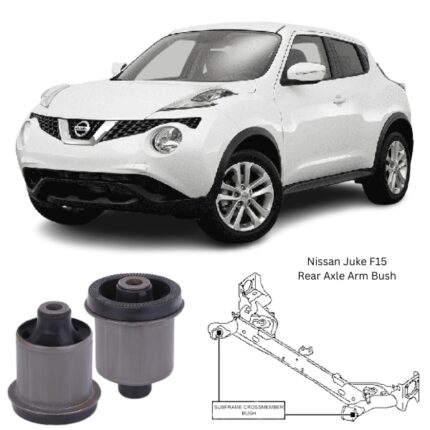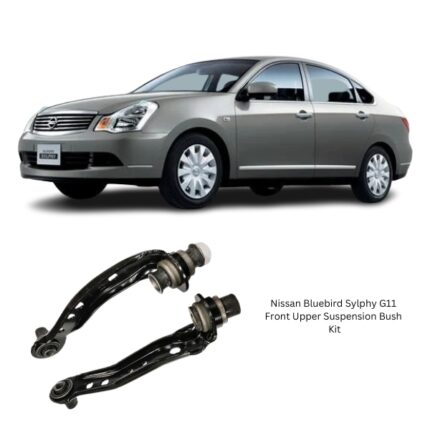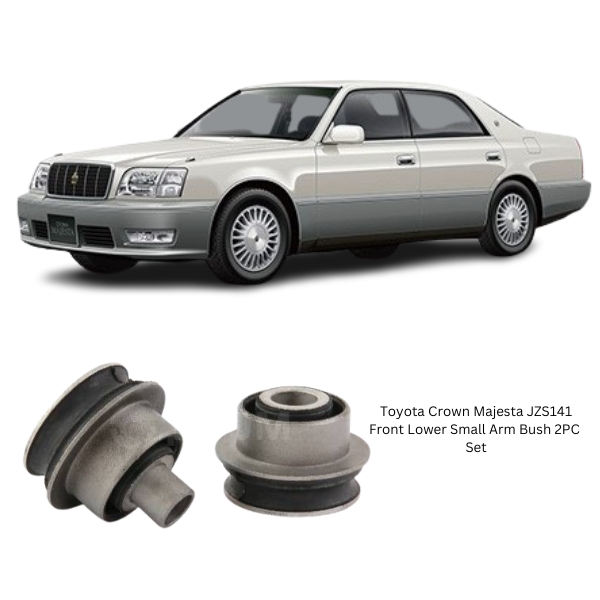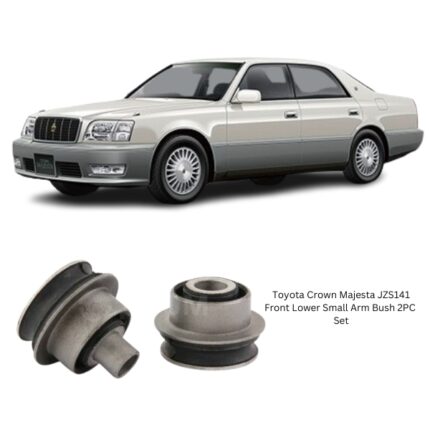Get Toyota Crown Majesta JZS141 Front Lower Small Arm Bush 2PC Set 48654-30300 in Kenya
The Front Lower Small Arm Bush is a vital component in a vehicle’s front suspension system. Despite its compact size and low-profile appearance, this bushing plays a critical role in maintaining alignment, absorbing road vibrations, and enabling safe and responsive handling. It serves as a flexible yet supportive mount between the front lower suspension arm—sometimes referred to as a control arm or wishbone—and the vehicle’s chassis or subframe.
Bushings are designed to replace rigid metal joints with vibration-isolating, noise-dampening material, usually high-durability rubber or polyurethane. The front lower small arm bush provides both flexibility and structural support, allowing controlled movement of the suspension arm while keeping the front wheel assembly securely aligned.
Whether navigating city streets or rough terrain, this bushing helps maintain smooth ride quality, stable steering, and safe vehicle operation. Failure to maintain this component can lead to uneven tire wear, poor handling, and even safety hazards.
Function and Purpose
The Front Lower Small Arm Bush connects the lower arm of the front suspension to the chassis or subframe and acts as a pivot point, allowing the control arm to move vertically as the vehicle travels over bumps or dips. It cushions this movement while ensuring alignment and stability are preserved.
Primary Functions:
-
Suspension Articulation Support
Allows controlled vertical movement of the lower arm as part of the vehicle’s suspension travel. -
Vibration and Shock Dampening
Absorbs road vibrations and shock loads to protect the chassis and improve cabin comfort. -
Noise Reduction
Prevents direct metal-to-metal contact between suspension components, reducing noise and harshness. -
Wheel Alignment Preservation
Maintains correct toe and camber angles of the front wheels, supporting safe handling and consistent tire wear. -
Lateral Force Management
Handles side loads generated during turning or cornering without deflecting excessively. -
Component Protection
Reduces fatigue and wear on the control arm, subframe, and surrounding suspension parts.
The bush is engineered to balance compliance (for comfort) with stiffness (for control), making it a key contributor to overall vehicle stability.
Design and Construction
The Front Lower Small Arm Bush is constructed using materials and geometry tailored to withstand constant dynamic loads while offering precise suspension response.
Key Components:
-
Outer Shell
Usually fabricated from steel or aluminum, the outer casing fits into the control arm or mounting bracket and provides structural integrity. -
Elastomeric Core (Rubber or Polyurethane)
A durable rubber or synthetic elastomer lies between the inner and outer sleeves. This material flexes to absorb vibrations and return to its original shape without cracking or tearing. -
Inner Sleeve
A tubular steel insert through which the mounting bolt passes. This part carries the torque and supports the connection to the vehicle’s subframe. -
Void Geometry (in some designs)
Some bushings are engineered with voids or directional grooves that control stiffness and optimize performance under specific loading conditions. -
Bonding Agent
A vulcanizing adhesive is used to permanently bond the rubber to the metal sleeves, preventing separation and maintaining alignment during operation.
Each component is designed to operate under high loads, frequent movement, and extreme environmental conditions without failure.
Performance Characteristics
A properly functioning Front Lower Small Arm Bush is essential for effective suspension operation. It must be resilient yet flexible enough to accommodate various driving stresses.
Performance Features:
-
High Load Capacity
Capable of supporting vehicle weight, braking forces, and cornering stress without deformation. -
Durability
Resists wear, cracking, and separation over tens of thousands of kilometers, even in demanding conditions. -
Low NVH Transmission
Minimizes the transmission of noise, vibration, and harshness into the vehicle cabin. -
Weather and Chemical Resistance
Designed to withstand temperature fluctuations, moisture, dirt, oil, and road salt without degradation. -
Directional Compliance
Allows movement in specific directions (usually vertical and slight angular motion) while resisting unwanted deflection.
Symptoms of Wear or Failure
Over time, the Front Lower Small Arm Bush will deteriorate due to road impact, environmental exposure, and mechanical fatigue. Recognizing the early signs of wear can prevent damage to other suspension components and maintain driving safety.
Common Symptoms Include:
-
Clunking or Knocking Noises
Caused by excessive play in the arm as the rubber degrades and the metal parts make contact. -
Steering Instability
A worn bush may allow the arm to shift under load, resulting in vague or imprecise steering response. -
Increased Road Vibration
More vibration and harshness transmitted to the cabin, especially when driving over uneven surfaces. -
Premature Tire Wear
Bush failure affects wheel alignment, leading to uneven or rapid tire wear patterns. -
Poor Braking Control
During braking, the front suspension may shift excessively, leading to instability or brake noise. -
Visual Deterioration
Cracked, torn, or separated rubber visible during a physical inspection of the bush.
Addressing these symptoms promptly by replacing the bush helps preserve overall vehicle performance and safety.
Installation Guidelines
Replacing a Front Lower Small Arm Bush involves removal of the control arm and pressing out the old bushing. This procedure may vary based on vehicle design but generally follows these steps:
-
Raise and Secure Vehicle
Use a lift or jack stands to safely raise the vehicle and remove the front wheel for access. -
Remove Control Arm
Unbolt the control arm from the subframe and steering knuckle. Support the suspension as needed. -
Extract Old Bush
Use a hydraulic press or specialized bushing tool to press out the worn bush from the control arm. -
Install New Bush
Lubricate and press the new bush into the control arm, ensuring proper alignment and seating. -
Reassemble and Torque
Reinstall the control arm and torque all bolts to the manufacturer’s specifications. -
Wheel Alignment
After replacement, a professional wheel alignment is recommended to restore suspension geometry.
Maintenance and Inspection
Bushings do not require regular lubrication but should be inspected periodically, particularly:
-
During routine suspension or brake service
-
When shocks, springs, or control arms are being replaced
-
After road impacts or accidents
Replacement intervals vary depending on driving habits and conditions but typically range from 60,000 to 100,000 kilometers.
Advantages of Timely Replacement
-
Improved Ride Comfort
Restores smooth, vibration-free driving over all surfaces. -
Consistent Steering and Handling
Ensures the control arm remains in proper alignment for safe and predictable cornering. -
Enhanced Safety
Maintains stable braking and suspension control, especially during sudden maneuvers. -
Extended Component Life
Reduces stress on adjacent parts such as ball joints, tie rods, and struts. -
Even Tire Wear
Preserves proper wheel alignment and extends tire lifespan.
Follow us on Facebook for more parts.





Reviews
Clear filtersThere are no reviews yet.